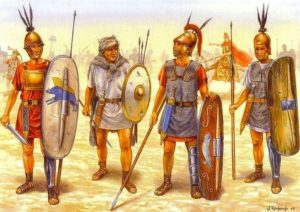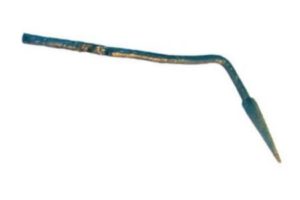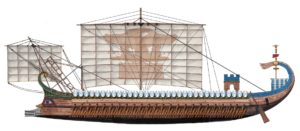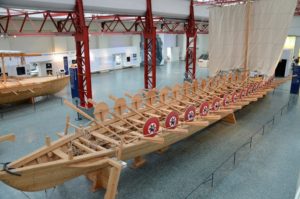Commander N Westphalen
Introduction
Previous articles describe the development from prehistory to the ancient Egyptians and Greeks, of a cycle whereby increasing trade required larger and more efficient ships to transport merchandise and better weapons to defend or attack them; both of which in turn facilitated further trading opportunities.1;2 However, it was not until the 18th century that Western medicine had developed sufficiently for its role as an enabler of this cycle to be recognised, which among other developments, made possible the European settlement of Australia.3
While the technical developments in weapons, ships and medicine driven by this cycle often developed independently in multiple regions worldwide, they remained closely linked throughout Western history in particular. This article describes the technical and other developments in Roman warfare, ships and medicine, from its foundation in c. 800 BCE to its demise in Western Europe in c. 500 CE.
Roman warfare
Previous articles describe how the scope of prehistoric warfare was limited by the supplies and social structures that sustained it, and a lack of reasons for conflict. Advances in weapons and their use during the 2000 years after 4000 BCE were made possible by societal developments that could sustain formed armies and—for better and for worse—provide them with the means and motives to fight.
Regarding the latter, Romans believed absolutely in defending their perceived cultural superiority and imposing it on others. War also provided prestige for the ruling class, whose career progression came from successful military endeavours. Hence, throughout its history, Rome was customarily either at war or preparing for one.4
The societal attributes supporting these motives included a vast pool of potential recruits, and an innovative and disciplined army, with a centralised command structure and the most robust logistics and engineering support of the era. The Romans also employed effective diplomacy through a network of allies, and an inclusive approach to conquered peoples. These attributes created synergies, whereby the roads and bases that supported Roman armies also promoted their influence and power among their erstwhile opponents who came under their rule.5
Conversely, the progressive collapse of the Roman’s societal institutions from 200 CE made their armies unsustainable. Power struggles that routinely led to the murder of the ruling emperor resulted in currency debasement, hyperinflation and economic depression, as well as civil unrest, mutinies, civil wars and external invasions. To these can be added the ‘Plague of Cyprian’ pandemic (250–270 CE), which killed two emperors and at one point claimed up to 5000 people daily within Rome itself. These calamities led to the demise of the Western Roman Empire by 476 CE, leaving the Eastern or Byzantine Empire to continue until its capital Byzantium (modern Istanbul) fell to the Ottoman Turks in 1453 CE.6
Monarchic and republican Roman armies used the Greek phalanx formation until c. 300 BCE when their largest unit became the legion, consisting of 4 200 heavy infantry divided into 30 divisions or maniples. Each legion was supported by 800–1200 light infantry (velites), often from Rome’s allies, and 300 cavalry.7
In battle, the maniples deployed in three lines in a chequerboard formation (quincunx), with the younger hastate in front, followed by the more seasoned principes and the veteran triarii behind. This allowed each forward row to fight hand-to- hand, and then withdraw behind the third line while the second moved forward to take their turn. This tactic kept fresh and rested men in action against progressively more tired opponents until the latter broke. Meanwhile, the velites and cavalry formed a protective screen for the maniples while harassing the enemy from the flanks.8
From c100 BCE, Roman legions were reorganised into 10 cohorts of 400–500 heavy infantry, each with six centuries of about 80 men. These continued to provide their own weapons and armour until the first permanent and entirely professional Roman army with a central command and logistics structure was formed in 31 BCE. This was followed in 6 CE by a dedicated military treasury (aerarium militare), which was funded by taxes and included a pension system.9
Each imperial Roman soldier received a bronze helmet (galea) with nape and cheek guards, and a reinforced rib across the forehead to protect against downward slashes. Their lorica segmentata, a segmented armour of iron weighing about 9 kg, afforded good protection for the chest and shoulders from spears, missiles and swords. They were armed with one or two javelins (pilae), which they threw before engaging in hand-to-hand combat. Each pilum spearhead had a long soft iron shank that bent on impact, making them harder to remove from opponents’ shields and rendered them useless for throwing back. Each soldier then used their left arm and shoulder to interlock their scutum, a heavy (~10 kg) curved rectangular shield, and charged their opponents to knock down and stab them, in a highly bloody form of ‘reverse crowd control’. They then kneeled behind their scutae and pushed them forward together, while using their short double-edged swords (gladii) in their right hand to slash and thrust.10
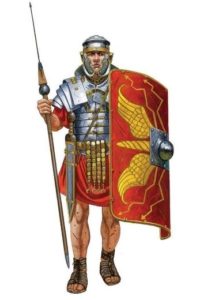
Imperial Roman legionary, post 31 BCE.12 From left to right, note the pilum, gladius, galea and lorica segmentata and scutum. His equipment clearly posed concerns when fighting at sea… even if he could swim.
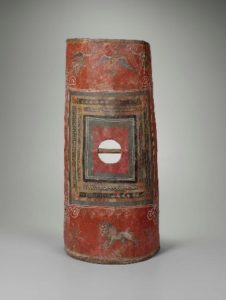
Original scutum, 200–300 CE, found in 13 pieces at Dura Europos in modern Syria.15 Note the horizontal carrying handle, which was originally covered by a metal plate or ‘boss’.
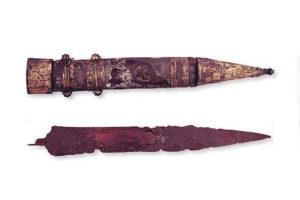
Original gladius and scabbard belonging to an officer of Tiberius, the second emperor of Rome (42 BCE–37 CE)16
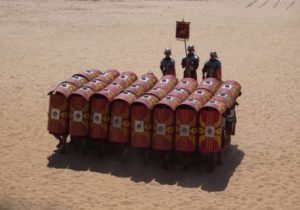
Re-enacted Roman testudo (tortoise) formation, typically used for assaulting fortified positions.17 Note the shields raised overhead by each rank to protect the one in front.
Roman ships
Although they had used warships to fight piracy since 400 BCE, the Romans did not develop a navy until the Punic Wars against Carthage (modern Tunis) from 264 to 146 BCE. The Carthaginians’ control of the sea between Tunisia and Sicily allowed them to dominate maritime trade throughout the Mediterranean. Besides the ensuing trade disputes, their military maritime power endangered Roman land power, by threatening the grain supplies from Sicily and Egypt that kept the average Roman (civilian and soldier) fed.18
The first Roman warships were little different to the old Greek trireme galleys. These had sails for longer journeys; while for battles at sea, their masts and sails were left ashore and the ship was rowed by up to 170 rowers arranged in three tiers or ‘banks’. Their speed and endurance under oars were limited by the strength and stamina of the rowers; while limited food and water stowage and the inability to cook or even sleep at sea meant the ships were beached ashore each night. Their primary tactic initially entailed sweeping close inboard to smash their opponents’ oars and injure the rowers, thereby rendering them susceptible to being sunk by ramming. Alternatively, their embarked soldiers comprising up to 14 archers and hoplites were used to shoot up their opponents’ crews before grappling and boarding. While their inability to row and fight simultaneously meant the rowers were not expected to engage in combat at sea, they still acted as light infantry ashore. Rowers were recruited locally from the poorer classes, but also included prisoners of war and slaves. 19
However, the most common warship used by both the Carthaginians and Romans became the quinquereme galley. These still had three banks of oars, but with two rowers per oar for the upper two banks. The increase from 170 to 300 rowers provided additional motive power, not only for ramming but to carry up to 120 rather than 14 soldiers to do at sea what the Romans were feared for ashore: fight hand-to-hand. The quinquereme’s additional space and payload capacity also allowed the carriage of deck-mounted, torsion-powered artillery weapons such as ballistae and catapults.20
The Romans further extrapolated land warfare to the sea, by mounting towers on their galleys from which archers shot regular and fire arrows. Another innovation was the corvus (‘raven’), a boarding gangway with a large iron spike at the end that penetrated an opponent’s deck on being dropped, to prevent their escape and allow boarding. The corvus was replaced from 36 BCE by the much lighter harpax, a catapult-launched grappling hook that could be winched in to drag opponents alongside.21
Following the naval victory by Octavian (later Emperor Augustus) over Antony and Cleopatra in 31 BCE, at Actium (near modern Arta, off the coast of western Greece), the lack of maritime opponents apart from pirates led to the displacement of most quinqueremes by smaller and lighter ships. These included the seagoing liburna, which had a single bank of oars with two rowers per oar, and the navis lusoria for riverine operations.22
To this end, Octavian established the classis Ravennatium at Ravenna in the northern Adriatic, and the classis Misenatium near modern Naples. Additional bases were established at Alexandria, Antioch, Rhodes, Sicily, Libya and Britain, while an additional fleet operated on the Rhine and another two on the Danube. Over the next four centuries, these fleets allowed Rome to quickly respond to military threats and maintain supplies for the army in its various campaigns until the progressive collapse of its societal institutions from 200 CE likewise made them unsustainable.23
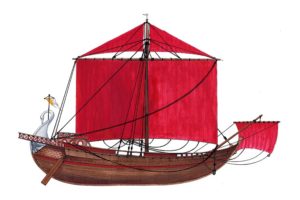
Roman corbita merchantman, 100–400CE.24 These ships were used to transport up to 400 tons of grain each, from Egypt and Sicily to feed Rome itself.
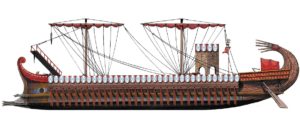
Roman quadreme (bireme with two rowers per oar), c. 260 BCE.26 Note the heavier overall build compared to the trireme, the corvus forward and the archery tower aft. Quinqueremes were similar but with five rowers for three banks of oars.
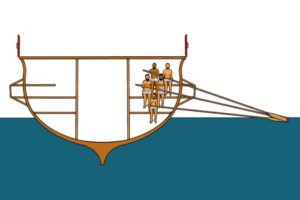
Cross-section, Roman quinquereme, c. 260 BCE.27 Note the rower arrangement (in particular the lack of freeboard), and the amount of upper deck space for troops and artillery weapons.

Deck-mounted ballista and harpax projectile used for grappling, c. 31 BCE28 A smaller version of the ballista (scorpio) was used as an anti-personnel weapon.

Roman liburna, c. 150 CE, used for grain ship convoy escort and counterpiracy operations.29 Note the non-functional
ram-shaped bow.
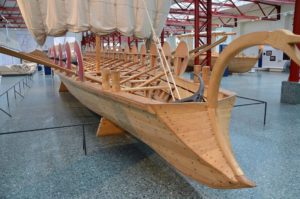
Forward view, replica Roman navis lusoria, c. 300 CE, Mainz Museum Germany.30 Used on the Rhine as a troop transport. Note the faux ram bow.
Roman medicine
Traditional Roman medicine was originally administered by the head of each family (paterfamilias), using water and wine combined with massage, bathing and gentle exercise. This contrasted with the somewhat more robust Greek approach, whose influence in Rome began with a series of epidemics that led to the construction of the Temple of Apollo in 430 BCE, followed by worshipping his son Asclepius, the demi-god of healing, from 292 BCE. The first known Greek medical practitioner in Rome was Archagathus of Sparta in 219 BCE, who specialised in battle wounds and dermatology.32
However, the Romans quickly expanded on their Greek medical forebears, if at times with limited actual therapeutic effect. Although it remains unclear whether he practised medicine himself, Aulus Cornelius Celsus (c. 25 BCE–50 CE) wrote an encyclopedia, of which only the seventh volume De Medicina survives. Besides lamenting the practice of medicine for financial gain, Celsus was the first writer to distinguish between ‘empiricists’, who believed that trustworthy medical knowledge had to be based on actual observations of ill health and treatment outcomes, and ‘dogmatics’, who insisted that it depended on understanding the underlying causes and mechanisms that explain how treatments work.33
Celsus was also the first Greco-Roman author to deal systematically with ophthalmology and oculoplastic surgery. While he believed dietetics was the most important branch of medicine, less usefully he divided food into that which cooled the patient (e.g. lettuce, cucumber, cherries and vinegar) and that which provided heat (e.g. pepper, salt, onions and wine). He also advocated eating snakes to treat abscesses and believed that drinking the blood of a slain gladiator cured epilepsy.34
Scribonius Largus (c. 1–50 CE) was a physician to the emperor Claudius, during the latter’s visit to Britain in 43 CE. Like other authors, he used Greek terms for medicine and plants and supported the Hippocratic Oath. His Compositiones had 271 remedies including a salve for arthritis, use of the trefoil plant against snakebites, and blood from turtles or doves (rather than gladiators) for epilepsy. He also indicated that doctors must help even enemies to the best of their ability.35
The most influential work on medications, however, was the five-volume De Materia Medica, which was written by Dioscurides of Anazarbus (modern Turkey) in c. 50–70 CE, and remained in use for the next 1700 years. Dioscurides described over 600 herbal and plant remedies, such as poppy juice and the autumn crocus that contain morphine and colchicine respectively. Somewhat less usefully, he also describes the helpful properties of specific stones if worn as amulets.36
The writings of Soranus of Ephesus (c. 60–130 CE) on obstetrics, gynaecology and paediatrics also remained in use for 1700 years. His advice to midwives and wet nurses in his Gynaecology stated they should be literate, sober, discreet, know both theory and practice and not be influenced by superstition. However, the latter advice was somewhat negated by Soranus reiterating the common belief that pregnancy was avoidable by holding one’s breath during intercourse or sneezing shortly after.37
Although the most important surgeons were Heliodorus (c. 60–140 CE) and Antyllus (c. 150 CE), very little of their written work survives. Like other ancient cultures, apart from concern for the patient’s comfort and acceptance of the futility of causing further pain when recovery was unlikely, the risks of surgery meant it was usually employed only as a last resort. While most surgery was therefore minor in scope, the development of specialised instruments facilitated more sophisticated operations such as cataract removal, draining of fluids, trephination and circumcision reversal. Dressings were of linen bandages or sponges kept either dry or wet, the latter using wine, oil, vinegar or water covered by fresh leaves. Wounds were stitched with flax, linen thread or metal pins.38
The most influential Roman physician remains Claudius Galenus, or Galen of Pergamon (129–c.216 CE). He studied in Smyrna and Alexandria, and worked at a gladiator school before becoming a prolific writer of medical treatises that were translated into many other languages. Galen was a favourite of several Roman emperors, and even claimed that Septimius Severus said of him after solving a stomach problem, ‘we have one doctor, and he is a consummate gentleman’.39
Although Galen gained considerable anatomical knowledge by treating wounded gladiators, a ban on human cadaver dissection from c. 250 BCE until after 1300 CE meant his research was otherwise limited to vivisecting Barbary apes and pigs. He ascertained which spinal nerve roots controlled which organs and muscles by cutting or stimulating them, and discovered that it was the kidneys and not the bladder that produces urine, by clamping the ureters of living apes and watching the kidneys swell.40
However, Galen erred regarding the role of the veins with respect to returning blood to the heart, while a misunderstanding of his writings regarding the need to drain abscesses led to a belief that ‘laudable pus’ was a positive sign of wound healing. Furthermore, he also supported the Greek Hippocratic Corpus regarding the idea that illness was caused by imbalances of the four bodily fluids (or humours) of phlegm, yellow bile, black bile and blood. This idea was coupled with the four qualities of heat, cold, wet and dry, which underpinned all treatments in Western Europe for the next 1600 years. Among other shortfalls, this theory of illness led to the use of bloodletting as a treatment and the view that diseases such as malaria were caused by bad air from rotting animal and plant matter.41
The most common conditions presenting to Roman physicians were skin, digestion and fertility disorders, fractures, gout (podagra), depression (melancholia), dropsy or fluid retention (leukophlegmasia) and epilepsy (comitialis). They knew that penetrating head, chest and abdominal injuries were usually fatal and protected their medical reputations by avoiding such cases. This highlights the relevance of Celsus’s advice that the pointing of the nose, sunken temples and eyes, cold ears and the skin of the forehead being taut and hard indicated the imminent death of a patient.42
Health care for Roman soldiers was mostly limited to self-care and buddy aid until after 31 BCE. They had their own bandages—on at least one occasion they used them on uninjured limbs to avoid battle. Considerable reliance was also placed on civilian assistance, in particular the local paterfamilias. Otherwise, Roman battlefield medical attendants formed part of the commander’s retinue.43
The establishment of a permanent Roman army led to the first soldiers to be exempt from non- medical duties. These milites medici included a medicus legionis who was appointed to each legion, while medici cohora were assigned to cohorts. The Romans also developed valetudinaria or tented field hospitals capable of holding up to 200 sick and wounded, in the charge of a medicus castrensis or castrorum. By 100 CE, the mobile valetudinaria had led to fixed military hospitals. Meanwhile, the two fleets established by Augustus were provided with physicians, and each trireme likely had a medicus triremis, while the larger vessels may have carried more. However, Roman milites medici were never formed into a discrete medical corps but functioned independently of each other as part of their assigned unit, which endured in English (and later British) armies until the 1870s.44
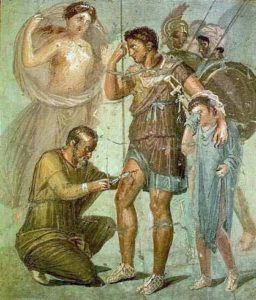
Fresco of the Trojan (later Roman) hero Aeneas receiving treatment for a leg wound (possibly the removal of an arrowhead), Pompeii (destroyed 79 CE).45
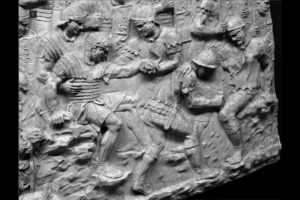
Roman battle casualties, Dacian Wars (modern Romania), 101–106 CE.46 To the left, a legionary is assisted by another (behind), while a medicus in auxiliary dress holds his arm. On the right, an auxiliary is having his right thigh bandaged by another medicus standing front centre.
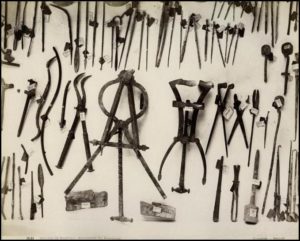
Roman surgical instruments, found at Pompeii (destroyed 79 CE).47 They include spatulas, scalpels, probes, curettes, bone hooks, forceps, awls and levers, male catheters and a
rectal speculum. The large fearsome-looking instrument centre-left is a tissue spreader and the one centre-right a vaginal speculum.
Conclusion
By the birth of Christ, Roman societal developments not only made possible a permanent and entirely professional army, but also the most sophisticated central command and logistics structures of the era that even included health and pension services. The use of this force was driven by their perceived cultural superiority and career development of the ruling class.
Like the Greeks, Roman naval warfare entailed cramming hundreds of men aboard ships with very lightly built hulls and limited freeboard. All were susceptible to penetrating injuries from spears and arrows, while an under-recognised risk in the literature pertains to blunt force trauma from the rower’s own oars, if they failed to unship them fast enough to prevent them being smashed. Unlike the Greeks, however, the Romans relied less on ramming in favour of grappling and boarding with larger numbers of embarked troops, who were supported by torsion-powered artillery weapons more often found on land.
Although Roman sea battles were still mostly fought close inshore, the more-or-less universal inability to swim meant that ending up in the water would have been fatal. The number of wounded would therefore have been limited to ships that were not sunk, or were beached before they did. The proximity to land and absence of on-board space would also have led to the embarked medici triremis treating their seagoing battle casualties ashore, on more-or-less the same terms as if they had been fighting on land.
While the presence of a medicus legionis on a legion’s staff hypothetically made it possible to conduct health planning and supervision, such activities were probably embryonic at best. Forward and tactical casualty evacuation via valetudinaria to fixed health facilities was likewise feasible; however, as the state of overland transport limited and the state of the medical art at that time obviated the need for a strategic medical evacuation capability, soldiers either recovered or died in situ.
Humanitarian aid / disaster relief was most likely ad hoc and presumably limited to dependants and their supporting civilians, while assessing suitability for employment and deployment was most likely ‘on- the-job’. Although the need for a healthy lifestyle with a systemic approach to their observations, while that of his ‘dogmatics’ was negated by physiological theories of disease causation that were more plausible than based on hard fact. While Galen’s acceptance of the humoural theory of disease stymied any meaningful physiological research for the next 1600 years, it seems likely such research would have been problematic in any case until formal scientific methods were developed in the 17th century. Roman medicine was further constrained by Galen’s anatomical errors caused by a ban on human dissection.
Even so, Roman surgical capabilities—if not their anaesthetics, analgesia and post-operative wound care—probably compared relatively well with current practice; at least for limb injuries and minor wounds.
Author
Dr Neil Westphalen graduated from Adelaide University in 1985 and joined the RAN in 1987. He is an RAN Staff Course graduate and a Fellow of the Royal Australian College of General Practitioners, the Australasian Faculty of Occupational and Environmental Medicine, and the Australasian College of Aerospace Medicine. He also holds a Diploma of Aviation Medicine and a Master of Public Health.
His seagoing service includes HMA Ships Swan, Stalwart, Success, Sydney, Perth and Choules. Deployments include DAMASK VII, RIMPAC 96, TANAGER, RELEX II, GEMSBOK, TALISMAN SABRE 07, RENDERSAFE 14, SEA RAIDER 15, KAKADU 16 and SEA HORIZON 17. His service ashore includes clinical roles at Cerberus, Penguin, Kuttabul, Albatross and Stirling, and staff positions as J07 (Director Health) at the then HQAST, Director Navy Occupational and Environmental Health, Director of Navy Health, Joint Health Command SO1 MEC Advisory and Review Services, and Fleet Medical Officer (2013–2016).
Commander Westphalen transferred to the Active Reserve in July 2016.
Disclaimer
The views expressed in this article are the author’s and do not necessarily reflect those of the RAN or any other organisations mentioned.
Corresponding Author: Neil Westphalen, neil.westphalen@bigpond.com
Authors: N Westphalen 1,2
Author Affiliations:
1 Royal Australian Navy Reserve
2 Navy Health Service, C/O Director Navy Health



